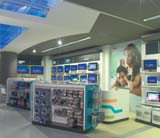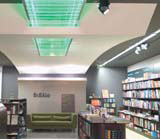Heightened experience
Public aims to bring its brand alive by mixing entertainment with media technology and making the consumer feel involved. After the success of its debut experiential retail outlet in Greece, it is set to take Eastern Europe by storm, says Clare Dowdy.

Public aims to bring its brand alive by mixing entertainment with media technology and making the consumer feel involved. After the success of its debut experiential retail outlet in Greece, it is set to take Eastern Europe by storm, says Clare Dowdy
After the Athens Olympics in 2004, a new social group was defined in Greece/ the people with their finger on the fast-forward button. More specifically, they are 18- to 34-year-old ABC1s who see Greece as part of Europe. And, what’s more, they make up the upper 40 per cent of the population.
This is the group to which a new entertainment store is hoping to appeal. And the plan is to do it, not just with carefully selected products, but with experiential retail – something of a departure for most Greek shoppers.
Called Public, it is a new proposition, courtesy of Germanos Group, a technology company with a string of businesses, including Greece’s answer to Carphone Warehouse. Public was developed by 141 Red, which handled the retail environment design, and Ogilvy Bold, Germanos’s advertising and marketing agency.
The first Public opened last October to the tune of €6m (£4.1m), in Greece’s biggest university city, Thessaloniki. A second store in Athens (which will be as big as London’s Nike Town) will follow early this year. If all goes to plan, there will be ten Public sites across Greece in the next decade. And exportation of the brand to Germanos’s existing overseas territories of Bulgaria, Romania, Poland and Hungary is likely to start in 2007, according to Fernando Guerreiro, managing director of Public.
Public’s unique selling point is its mixing of popular entertainment and the equipment to play it on, in an attempt to inspire customers into repeat visits and ever-larger baskets. So, in some areas, DVDs and CDs sit alongside the appropriate technology. Books also get a look in, allowing items to be displayed by theme rather than by category. So a book and a DVD of the same film could rub shoulders with the CD of the soundtrack, which might sit next to an MP3 player. Much of this cross-categorising goes on at 141 Red’s gondolas.
Navigation is key and different zones are carefully distinguished with colours and materials. Simon Clarke, senior designer at 141 Red, explains, ‘CDs and DVDs are surrounded by white and orange acrylic, while the books are displayed on darker, wooden shelving.’ With the emphasis on trial and selection, hi-tech products are not mere displays, but are plugged in and usable. As Antonis Kocheilas, strategic planning director at Ogilvy Bold, says, ‘the store literally comes alive’.

The emphasis is on enticement and temptation, as customers are drawn through the store by a variety of levels and colour palettes, which aim to change the mood of each zone. Ambient lighting is a key design element and is used to ‘pull’ consumers through the store. All lighting has been designed to fit into concealed areas, so at no point do you see light fixtures – just the glow of light. This is critical to the overall design of the store, says Clarke, as light has been used to accentuate walkways from category to category.
While France’s Fnac has opened in Greece in recent months, Kocheilas believes that Public outstrips it on its technology offer. Clarke backs this up, claiming ‘the range of products are not on offer anywhere else in Greece’.
Meanwhile, experiential retail comes in the form of a studio where customers can record their own music, along with live acts and promotional activities.
So Public has two raisons d’être: product editing and bringing the brand alive. Kocheilas points to the way the Apple Store ‘manifests Apple in-store’. ‘We have tried to do that with a multibrand retailer,’ he says. l
-
Post a comment




